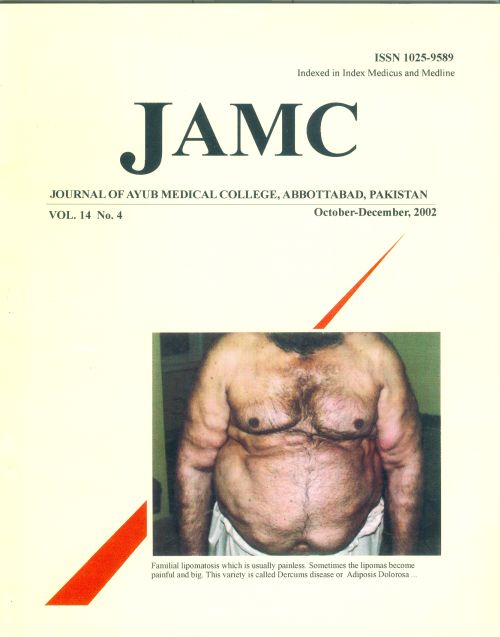IATROGENIC BILE DUCT INJURIES: EXPERIENCE AT PIMS
Abstract
Background: Cholecystectomy is one of the most familiar and commonly performed elective operation in general surgery. However, bile duct injury is a rare but one of the worst complications of this procedure. Although infrequent in expert hands, it is usually encountered when comparatively inexperienced surgeons are operating. These injuries present at variable time after the primary surgery. The prompt recognition and active management affects the morbidity and mortality associated with it. We evaluated the data of the hospital to find out the nature of injuries inflicted to extra hepatic bile duct and its management. Methods: This is a study of 20 cases of iatrogenic bile duct injury managed at the Department of Surgery Unit 1, PIMS. The study includes cases that had undergone cholecystectomy, open or laparoscopic in previous 11 years and sustained injury to the biliary tree and were managed accordingly. Patients with hepatobiliary malignancy were excluded. Results: Twenty cases were found to have various types of bile duct injuries. All patients were females, and their average age was 35 years. In four cases the injury occurred during surgery at our hospital, while remaining 16 cases were referred from other hospitals. All the patients were explored and managed accordingly. They had uneventful recovery and had good outcome at 6 months. Conclusion: Although the fact is that, the sooner an injury is recognized and treated, the better is the outcome. However, in this study the duration of injury had no effect on final outcome.
KEYWORDS: Bile duct injuries, Cholecystectomy, Iatrogenic.
References
Ahrendt SA, Pitt HA. Biliary tract. In: CM Townsend. Sabiston Textbook of Surgery. WB Saunders Company, Philadephia, Pennsylvania. 2001: 1076- 1111.
Neuhaus P, Schmidt SC, Hintze RE, Adler A, Veltzke W, Raakow R, et al. Classification and treatment of bile duct injuries after laparoscopic cholecystectomy. Chirurg 2000; 71(2): 166-73.
Branum G, Schmitt C, Baillie J, Suhocki P, Baker M, Davidoff A. Management of major biliary complications after laparoscopic cholecystectomy. Ann of Surg 1993 ;( 217): 532-41.
ldar S, Sabo E, Nash E, Abrahamson J, Matter I. laparoscopic versus open cholecystectomy in acute cholecystitis Surg Laparosc Endosc 1997;7(5):407-14
Zacks SL, Sandler RS, Rutledge R, Brown RS. A population-based cohort study comparing laparoscopic cholecystectomy and open cholecystectomy. Am J Gastroenterol 2002;97(2):334-40
Pleas HCC, Garden OJ. Bile duct injury: prevention and management. Johnson CD, Taylor I. Ed. Recent Advances in Surgery. Churchill Livingston. 1998, 21:1-16.
Ahrendt SA, Pitt Ha. Surgical therapy of iatrogenic lesions of biliary tract. World J Surg 2001; 25(10)):1360-5
Azagra JS, De Simone P, Goergen M. Is there a place for laparoscopy in management of post cholecystectomy biliary injuries? World J Surg 2001; 25(10): 1331-4
Huang ZQ, Huang XQ. Changing patters of traumatic bile duct injuries: a review of forty years experience. World J Gastroenterol 2002;8(1):5-12
Fletcer DR, Hobbs MS, Tan P, Valinsky LJ, Hockey RL, Pikora TJ, et al. Complications of cholecystectomy: risks of the laparoscopic approach and protective effect of operative cholangiography. Ann Surg 1999; 229(4):449-57
Chaudhary A, Negi SS, Puri SK, Narang P. Comparison of magnetic resonance cholangiography and percutaneous transhepatic cholangiography in the evaluation of bile duct strictures after cholecystectomy. Br J Surg 2002;89(4):433-6
Polat F R, Abci I, Coskun I, Uranues S. The importance of intraoperative Cholecystectomy. JSLS 2000; 4: 103-7.
Csendes A, Navarrete C, Burdiles P, Yarmuch J. Treatment of Common bile duct injuries during laparoscopic cholecystectomy: Endoscopy and surgical management World J Surg 2001;10:121-5
Raute M, Podlech P, Jaschke W, Manegold BC, Trede M, Chir B. Management of bile duct injuries and strictures following cholecystectomy. World J Surg 1993; 17, 553-62.
Sawaya DE Jr, Johnson LW, Sittig K, McDonald JC, Zibari GB. Iatrogenic and non iatrogenic extrahepatic biliary tract injuries: a multi-institutional review. Am Surg 2001; 67(5): 473-7
Jeffery S B, Gerald MF, Alan NB, Harvey HS, John EH, Jacob G et al. Cholecystectomy without operative Cholangiography. Ann of Surg 1993; 218: 371-9.
Al-Ghnaniem R, Benjamin IS. Long term outcome of hepaticojejunostomy with routine access loop formation following iatrogenic bile duct injury. Br J Surg 2002; 89(9): 1118-24.
Palacio-Ve'lez F, Casro-Mendoza A, Oliver Guerra AR. Results of 21 years of surgery for related iatrogenic bile duct injuries. Rev Gastroenterol Mex 2002;67(2): 76-81
Azagra JS, De Simone P, Goergen M. Is there a place for laparoscopy in management of post cholecystectomy biliary injuries? World J Surg 2001; 25(10): 1331-4
Downloads
How to Cite
Issue
Section
License
Journal of Ayub Medical College, Abbottabad is an OPEN ACCESS JOURNAL which means that all content is FREELY available without charge to all users whether registered with the journal or not. The work published by J Ayub Med Coll Abbottabad is licensed and distributed under the creative commons License CC BY ND Attribution-NoDerivs. Material printed in this journal is OPEN to access, and are FREE for use in academic and research work with proper citation. J Ayub Med Coll Abbottabad accepts only original material for publication with the understanding that except for abstracts, no part of the data has been published or will be submitted for publication elsewhere before appearing in J Ayub Med Coll Abbottabad. The Editorial Board of J Ayub Med Coll Abbottabad makes every effort to ensure the accuracy and authenticity of material printed in J Ayub Med Coll Abbottabad. However, conclusions and statements expressed are views of the authors and do not reflect the opinion/policy of J Ayub Med Coll Abbottabad or the Editorial Board.
USERS are allowed to read, download, copy, distribute, print, search, or link to the full texts of the articles, or use them for any other lawful purpose, without asking prior permission from the publisher or the author. This is in accordance with the BOAI definition of open access.
AUTHORS retain the rights of free downloading/unlimited e-print of full text and sharing/disseminating the article without any restriction, by any means including twitter, scholarly collaboration networks such as ResearchGate, Academia.eu, and social media sites such as Twitter, LinkedIn, Google Scholar and any other professional or academic networking site.










